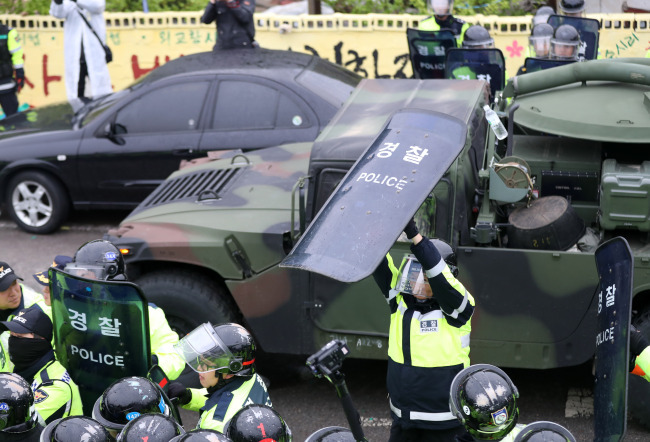The US Forces Korea on Wednesday brought launchers, a radar and other key parts of its advanced missile defense system to its deployment site, in a surprise move to accelerate the process ahead of a presidential election here amid heightened tension on the peninsula.
Some 20 trailers carrying key components of the Terminal High Altitude Area Defense system arrived at the site at dawn in Seongju, North Gyeongsang Province. Although covered by plastic boxes and wrapping, they were believed to include a radar, launchers, interceptors, a fire control and communications unit, a power generator and a cooler.
Some 20 trailers carrying key components of the Terminal High Altitude Area Defense system arrived at the site at dawn in Seongju, North Gyeongsang Province. Although covered by plastic boxes and wrapping, they were believed to include a radar, launchers, interceptors, a fire control and communications unit, a power generator and a cooler.

“Today’s measure is aimed to secure operational capabilities by moving some of the available THAAD components to the site,” Seoul’s Defense Ministry said in a statement, noting the system would be in “full operation” within this year.
“We’ve decided to first deploy parts of the system which do not require the construction of supporting facilities.”
Reiterating that THAAD is a “defensive weapon system,” the Pentagon said in a statement that the deployment is a “critical measure” to defend South Korea and its alliance forces against North Korea’s nuclear and ballistic missile programs.
However, the move triggered backlash from some of South Korea’s leading presidential candidates, as well as from China, which argues the program is directed at it.
Front-runner Moon Jae-in of the Democratic Party of Korea and runner-up Ahn Cheol-soo of the People’s Party criticized the government for what they deemed a rushed process that lacks due environmental impact assessment.
Beijing urged the equipment’s withdrawal, warning it would take the “necessary steps needed to protect” its own interests.
“THAAD in South Korea will only destroy the strategic balance and provoke further tension,” China’s Foreign Ministry spokesperson Geng Shuang said at a news briefing.
“(The system) will bring a grave damage to China’s strategic and safety interests. ... We strongly urge the US and South Korea to cease the actions, repeal the deployment and remove the related components.”

The development apparently reflects the allies’ efforts to speed up the system’s installment so as to minimize room for the next South Korean leader to upend the decision. The next president is to be elected on May 9.
As part of the efforts, South Korea handed over the site, which was formerly a golf course, to the USFK last week and decided to put off the construction of related facilities, as well as the environmental impact assessment. With the core assets now at the site, the system will soon be able to be put into operation once they are connected to one another.
The ministry pledged to proceed with the remaining procedure as scheduled including the construction of necessary facilities and the environmental impact assessment.
It remains unclear how many launchers have been and will ultimately be brought to Seongju, though some observers say there will be two to three. A THAAD battery typically comprises of six truck-mounted launchers, 48 interceptors, a fire control and communications unit, an AN/TPY-2 radar and other auxiliary equipment.
The transfer began around midnight and the police cordoned off roads leading to the county. Following the assets’ arrival at daybreak, activists and residents staged a protest, leading to a violent clash that left 10 people injured and several others arrested, according to a local group that opposes the THAAD deployment.
The US began moving the first batch of THAAD elements to South Korea early last month, after North Korea test-fired a ballistic missile. The system will be under the command of the 35th Air Defense Artillery Brigade of the US Army.
By Yeo Jun-suk (jasonyeo@heraldcorp.com)




![[Herald Interview] 'Amid aging population, Korea to invite more young professionals from overseas'](http://res.heraldm.com/phpwas/restmb_idxmake.php?idx=644&simg=/content/image/2024/04/24/20240424050844_0.jpg&u=20240424200058)











![[KH Explains] Korean shipbuilding stocks rally: Real growth or bubble?](http://res.heraldm.com/phpwas/restmb_idxmake.php?idx=652&simg=/content/image/2024/04/25/20240425050656_0.jpg&u=)

